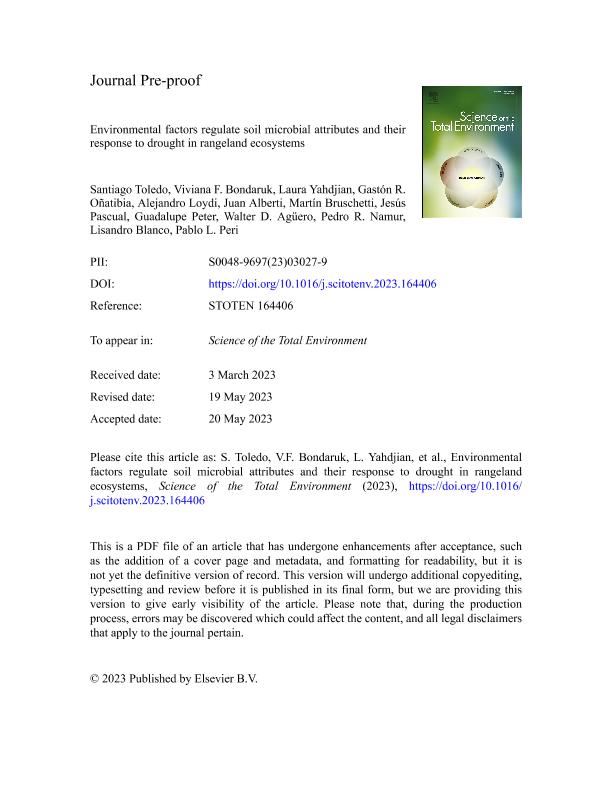Artículo
Environmental factors regulate soil microbial attributes and their response to drought in rangeland ecosystems
Toledo, Santiago ; Bondaruk, Viviana
; Bondaruk, Viviana ; Yahdjian, María Laura
; Yahdjian, María Laura ; Oñatibia, Gastón Rafael
; Oñatibia, Gastón Rafael ; Loydi, Alejandro
; Loydi, Alejandro ; Alberti, Juan
; Alberti, Juan ; Bruschetti, Carlos Martin
; Bruschetti, Carlos Martin ; Pascual, Jesus Maria
; Pascual, Jesus Maria ; Peter, Guadalupe
; Peter, Guadalupe ; Agüero, Walter D.; Namur, Pedro R.; Blanco, Lisandro Javier; Peri, Pablo Luis
; Agüero, Walter D.; Namur, Pedro R.; Blanco, Lisandro Javier; Peri, Pablo Luis
 ; Bondaruk, Viviana
; Bondaruk, Viviana ; Yahdjian, María Laura
; Yahdjian, María Laura ; Oñatibia, Gastón Rafael
; Oñatibia, Gastón Rafael ; Loydi, Alejandro
; Loydi, Alejandro ; Alberti, Juan
; Alberti, Juan ; Bruschetti, Carlos Martin
; Bruschetti, Carlos Martin ; Pascual, Jesus Maria
; Pascual, Jesus Maria ; Peter, Guadalupe
; Peter, Guadalupe ; Agüero, Walter D.; Namur, Pedro R.; Blanco, Lisandro Javier; Peri, Pablo Luis
; Agüero, Walter D.; Namur, Pedro R.; Blanco, Lisandro Javier; Peri, Pablo Luis
Fecha de publicación:
09/2023
Editorial:
Elsevier
Revista:
Science of the Total Environment
ISSN:
0048-9697
Idioma:
Inglés
Tipo de recurso:
Artículo publicado
Clasificación temática:
Resumen
In ecosystems, soil microbial variables characterization are used to determine soil biological health and the response of soils to environmental stress. Although there are strong associations between plants and soil microorganisms, they may respond asynchronously to environmental factors and severe droughts. We aimed to: I) evaluate the special variation of soil microbiome such as microbial biomass carbon (MBC) and nitrogen (MBN), soil basal respiration (SBR) and microbial indexes in eight rangeland sites located across an aridity gradient (distributed from arid to mesic climates); II) analyze the relative importance of main environmental factors (climate, soils, and plants) and their relationships with microbial variables in the rangelands; and III) assess the effect of drought on microbial and plant variables in field-based manipulative experiments. First, we found significant changes of microbial variables along a precipitation and temperature gradient. The responses of MBC and MBN were strongly dependent on soil pH, soil nitrogen (N), soil organic carbon (SOC), C:N ratio and vegetation cover. In contrast, SBR was influenced by the aridity index (AI), the mean annual precipitation (MAP), the soil pH and vegetation cover. MBC, MBN and SBR were negatively related with soil pH compared to the other factors (C, N, C:N, vegetation cover, MAP and AI) that had a positive relationship. Second, we found a stronger soil microbial variables response to drought in arid sites compared to humid rangelands. Third, the responses of MBC, MBN, and SBR to drought showed positive relationships with vegetation cover and aboveground biomass, but with different regression slopes, this suggest that plant and microbial communities responded differently to drought. The results from this study improve our understanding about the microbial response to drought in different rangelands, and may facilitate the development of predictive models on responses of soil microorganisms in carbon cycle under global change scenarios.
Archivos asociados
Licencia
Identificadores
Colecciones
Articulos(CERZOS)
Articulos de CENTRO REC.NAT.RENOVABLES DE ZONA SEMIARIDA(I)
Articulos de CENTRO REC.NAT.RENOVABLES DE ZONA SEMIARIDA(I)
Articulos(IFEVA)
Articulos de INST.D/INV.FISIOLOGICAS Y ECO.VINCULADAS A L/AGRIC
Articulos de INST.D/INV.FISIOLOGICAS Y ECO.VINCULADAS A L/AGRIC
Articulos(IIMYC)
Articulos de INSTITUTO DE INVESTIGACIONES MARINAS Y COSTERAS
Articulos de INSTITUTO DE INVESTIGACIONES MARINAS Y COSTERAS
Articulos(SEDE CENTRAL)
Articulos de SEDE CENTRAL
Articulos de SEDE CENTRAL
Citación
Toledo, Santiago; Bondaruk, Viviana; Yahdjian, María Laura; Oñatibia, Gastón Rafael; Loydi, Alejandro; et al.; Environmental factors regulate soil microbial attributes and their response to drought in rangeland ecosystems; Elsevier; Science of the Total Environment; 892; 9-2023; 1-12
Compartir
Altmétricas



